A
Auto Express
Guest
The Citroen Relay has been a popular panel van for many years, in part due to some favourable finance offers from Citroen. It first arrived in 2006, and in 2014 an updated and improved version was launched to keep pace with its main rivals: the Ford Transit, Mercedes Sprinter and Volkswagen Crafter. It was updated again with the addition of Euro 6 emissions-compliant diesel engines in 2016, although it was only the engines that were updated, so the Relay can't match newer rivals for tech.
The Relay, known as the Citroen Jumper everywhere other than the UK, uses a bodyshell and platform that's shared with the Peugeot Boxer and Fiat Ducato - in fact, there are so few differences between the three vans that it can be hard to tell them apart. The one big difference is under that short bonnet, where Fiat uses its own engines and PSA opts for a different line-up. Peugeot and Citroen use 2.2-litre BlueHDi motors, and there are three power outputs to choose from.
Citroen says its focus on long-term running costs and its relationship with customers is the top reason to buy the Relay over its sister vans. The Relay has headlights and a grille inspired by the new range of Citroen cars, with large chevrons that blend into chrome strips on the nose. The optional LED strip inside the headlights is a nice touch, too.
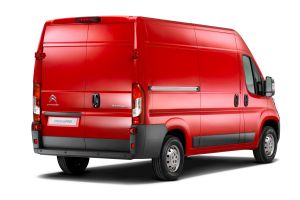
Citroen Relay 2014 rear

Citroen Relay 2014 - cab

Citroen Relay 2014 front
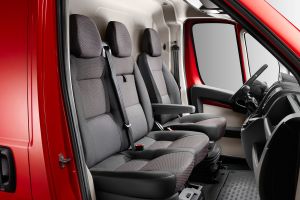
Citroen Relay 2014 seats

Citroen Relay - front view 2
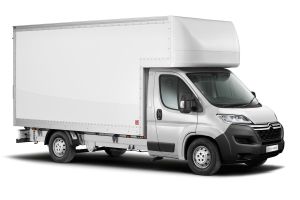
Citroen Relay 2014 - Luton
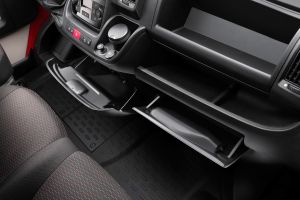
Citroen Relay 2014 storage

Citroen Relay - body sizes
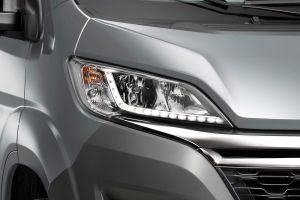
Citroen Relay - LED lights
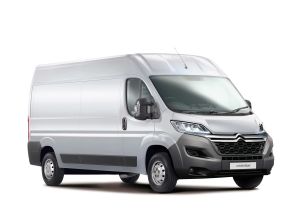
Citroen Relay 2014 - front and side view

Citroen Relay - touchscreen
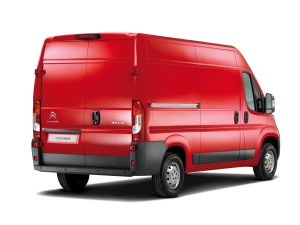
image
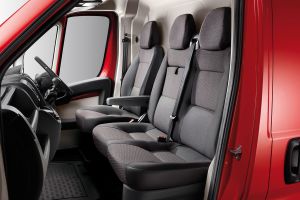
Citroen Relay - interior shot 2
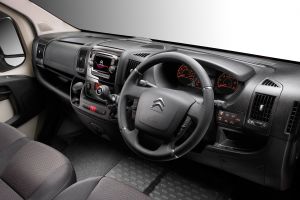
Citroen Relay - interior shot
The Relay has also been updated in more important areas - the doors and brakes have been tested and upgraded for durability, the engine range has been updated to improve emissions and economy, and interior quality has taken a step forward with extra options on the spec sheet. Sat-nav, a reversing camera, auto wipers, lane departure warning and tyre pressure sensors are all available.
The 2.2 BlueHDi diesels are badged 120, 140 or 165, although the latter is only available on Citroen's conversion ranges. All three feature fuel-saving stop-start as standard and a six-speed manual gearbox directs drive to the front wheels. There is no automatic transmission option, but Citroen does offer a Grip Control system that's designed to give the Relay some semblance of off-road ability.
• Best large panel vans to buy
For the panel van, payload capacities range from 1,125kg to 1,870kg, and load volumes go from 8 cubic metres in the L1H1 version to 17 cubic metres in the L4H3, which is the longest and tallest model. The Relay can also be had in a range of formats, including chassis cab, tipper, dropside and Luton, plus a host of the firm’s Ready To Run conversions.
Citroen offers X, Worker, Enterprise and Driver trims. X is pretty basic, while Worker adds some off-road ability by way of a selectable traction control system and all-season tyres. Enterprise offers a decent amount of kit, while Driver vans get kit such as a reversing camera, a Driver Assist pack and auto lights and wipers, among others.
Updates have helped to keep Relay in contention with rivals, but while it can't quite match the Ford Transit or Mercedes Sprinter in terms of driving, it does have a solid equipment list, a wide range of body styles and a practical cabin and load area.
The Relay's BlueHDi 120 diesel is only offered in the smallest H1L1 body combination, and Citroen quotes a combined WLTP economy range of 26.6-34.9mpg for this engine. The larger BlueHDi 140 diesel is only slightly behind, with combined WLTP figures ranging from 25.5-34.3mpg, irrespective of which body style you choose. The BlueHDi 165 has quoted figures of 19.1-30.6mpg, but these are so wide thanks to the different layout of Chassis Cab that are available, since this is the only way you can have this engine.
The long-term running costs of the Relay are a key factor for many customers, and the brand has worked hard to make sure the van pulls its weight over its whole lifetime. For example, the front bumper has been designed to separate into three parts - so that if the driver has a bump, only a small section will need to be repaired or changed.
Similarly, the tyres fitted were chosen specifically because they are a common and cost-effective size, so a van with a puncture will not be off the road for long while the right tyres are sourced.
Citroen's range of off-the-shelf conversions for the Relay also give buyers the opportunity to drive off in the perfect van of their choice with the minimum of hassle.

Citroen Relay 2014 rear

Citroen Relay 2014 - cab

Citroen Relay 2014 front

Citroen Relay 2014 seats

Citroen Relay - front view 2

Citroen Relay 2014 - Luton

Citroen Relay 2014 storage

Citroen Relay - body sizes

Citroen Relay - LED lights

Citroen Relay 2014 - front and side view

Citroen Relay - touchscreen

image

Citroen Relay - interior shot 2

Citroen Relay - interior shot
With four body lengths and three different heights, the Citroen Relay matches the Peugeot Boxer and Fiat Ducato for load space - and that means it has one of the best capacities in its class, as well as impressive versatility. Do note that the largest versions of the Relay weigh more than four tonnes, so for some drivers an HGV licence and tachograph will be required.

Citroen Relay 2014 rear

Citroen Relay 2014 - cab

Citroen Relay 2014 front

Citroen Relay 2014 seats

Citroen Relay - front view 2

Citroen Relay 2014 - Luton

Citroen Relay 2014 storage

Citroen Relay - body sizes

Citroen Relay - LED lights

Citroen Relay 2014 - front and side view

Citroen Relay - touchscreen

image

Citroen Relay - interior shot 2

Citroen Relay - interior shot
The Relay has a wide load bay, at 1,870mm between partitions and 1,422mm between the inner wheelarches. That means it can fit a Europallet in flat, and you can also load it into the side door, which is 1,250mm wide. The reinforced doors should help prevent damage if the forklift driver misses the gap, too.
The H3 versions of the Relay are 2,172mm high. The standard steel bulkhead has plenty of fixing points, and fits the full height of the van.
The rear doors open to 260 degrees, although this isn't easy to do with one hand. A sliding side door on the nearside is standard, and a second on the offside is also available.
As well as the panel vans, Citroen also offers a six-seater Crew Van and Window Van, and a wide range of three and six-seat Chassis Cab variants that are ready for conversion.
The improved durability of the parts used on the Relay should help its reliability, although it has never had a poor reputation in this area. The diesel engines in the range have been strong and there is no reason to believe that things will change with the latest Euro 6.2-compliant BlueHDi motors.
This latest model was subject to a rigorous testing programme before release. To put the new parts through their paces, Citroen conducted over 4million kilometres of test driving and 500,000 door slams.
Stability control, hill-start assist, ABS and emergency braking are all standard on the Relay, while the larger models also get lane departure warning (optional on smaller vans). A driver's airbag comes as standard, too. The improved brakes on the new model should boost safety as well.
The Citroen Relay is fairly easy to drive, with light steering, decent forward visibility and a logical interior layout. The gearbox isn't the best, with a lumpy shift, although the lever's position on the dash is comfortable enough to use.
All the engines remain pretty strong, and even the BlueHDi 120 is powerful enough to stay in top gear most of the time when on the motorway. We'd go for the 120 diesel if you're picking an L1H1 panel van, but you might want to opt for the BlueHDi 140 motor if you're going for a larger van that will be carrying heavier payloads.

The ride in the Relay is reasonably good, even without a load in the back. Over bumpy back roads the optional suspended driver's seat soaks up most of the bumps, but it gets irritating on faster roads - it undulates up and down, tightening and loosening your seatbelt. The Ford Transit is top of its class for ride quality, and the Mercedes Sprinter has more comfortable seats. Volkswagen's new front-wheel drive Crafter also offers a better combination of ride and comfort, leaving the Relay to struggle in comparison.
Road noise is also more noticeable, while the engine is still rather gruff when extended, too.
The interior on the current Relay is better than the previous models, but it still all feels very utilitarian. However, the addition of a small touchscreen display (optional) does make it feel more modern inside.
If you can stretch to the additional £800 it is well worth moving up from entry-level 'X' trim to Enterprise specification. This adds air conditioning, cruise control with a speed limiter, the touchscreen navigation pack with the 5-inch colour screen and steering wheel controls, rear parking sensors and a perimetric alarm.
The reversing camera and parking sensors are good options as well (standard on Driver trim), making backing into a tight spot less of a pain. The screen for the reversing camera displays two yellow lines that represent the rear doors, so you can park up without fear you won't get the doors open at the back.

The cabin has 13 different storage spaces, including a large overhead area and a locking central glovebox to keep valuables safe while loading and unloading.
The Relay comes with three seats as standard, including a pull-down table in the centre, but this can be done away with via the options list (at no extra cost).
(Width including door mirrors: 2,508mm)
(Width between wheel arches: 1,422mm)
Continue reading...
The Relay, known as the Citroen Jumper everywhere other than the UK, uses a bodyshell and platform that's shared with the Peugeot Boxer and Fiat Ducato - in fact, there are so few differences between the three vans that it can be hard to tell them apart. The one big difference is under that short bonnet, where Fiat uses its own engines and PSA opts for a different line-up. Peugeot and Citroen use 2.2-litre BlueHDi motors, and there are three power outputs to choose from.
Citroen says its focus on long-term running costs and its relationship with customers is the top reason to buy the Relay over its sister vans. The Relay has headlights and a grille inspired by the new range of Citroen cars, with large chevrons that blend into chrome strips on the nose. The optional LED strip inside the headlights is a nice touch, too.

Citroen Relay 2014 rear

Citroen Relay 2014 - cab

Citroen Relay 2014 front

Citroen Relay 2014 seats

Citroen Relay - front view 2

Citroen Relay 2014 - Luton

Citroen Relay 2014 storage

Citroen Relay - body sizes

Citroen Relay - LED lights

Citroen Relay 2014 - front and side view

Citroen Relay - touchscreen

image

Citroen Relay - interior shot 2

Citroen Relay - interior shot
The Relay has also been updated in more important areas - the doors and brakes have been tested and upgraded for durability, the engine range has been updated to improve emissions and economy, and interior quality has taken a step forward with extra options on the spec sheet. Sat-nav, a reversing camera, auto wipers, lane departure warning and tyre pressure sensors are all available.
The 2.2 BlueHDi diesels are badged 120, 140 or 165, although the latter is only available on Citroen's conversion ranges. All three feature fuel-saving stop-start as standard and a six-speed manual gearbox directs drive to the front wheels. There is no automatic transmission option, but Citroen does offer a Grip Control system that's designed to give the Relay some semblance of off-road ability.
• Best large panel vans to buy
For the panel van, payload capacities range from 1,125kg to 1,870kg, and load volumes go from 8 cubic metres in the L1H1 version to 17 cubic metres in the L4H3, which is the longest and tallest model. The Relay can also be had in a range of formats, including chassis cab, tipper, dropside and Luton, plus a host of the firm’s Ready To Run conversions.
Citroen offers X, Worker, Enterprise and Driver trims. X is pretty basic, while Worker adds some off-road ability by way of a selectable traction control system and all-season tyres. Enterprise offers a decent amount of kit, while Driver vans get kit such as a reversing camera, a Driver Assist pack and auto lights and wipers, among others.
Updates have helped to keep Relay in contention with rivals, but while it can't quite match the Ford Transit or Mercedes Sprinter in terms of driving, it does have a solid equipment list, a wide range of body styles and a practical cabin and load area.
The Relay's BlueHDi 120 diesel is only offered in the smallest H1L1 body combination, and Citroen quotes a combined WLTP economy range of 26.6-34.9mpg for this engine. The larger BlueHDi 140 diesel is only slightly behind, with combined WLTP figures ranging from 25.5-34.3mpg, irrespective of which body style you choose. The BlueHDi 165 has quoted figures of 19.1-30.6mpg, but these are so wide thanks to the different layout of Chassis Cab that are available, since this is the only way you can have this engine.
The long-term running costs of the Relay are a key factor for many customers, and the brand has worked hard to make sure the van pulls its weight over its whole lifetime. For example, the front bumper has been designed to separate into three parts - so that if the driver has a bump, only a small section will need to be repaired or changed.
Similarly, the tyres fitted were chosen specifically because they are a common and cost-effective size, so a van with a puncture will not be off the road for long while the right tyres are sourced.
Citroen's range of off-the-shelf conversions for the Relay also give buyers the opportunity to drive off in the perfect van of their choice with the minimum of hassle.

Citroen Relay 2014 rear

Citroen Relay 2014 - cab

Citroen Relay 2014 front

Citroen Relay 2014 seats

Citroen Relay - front view 2

Citroen Relay 2014 - Luton

Citroen Relay 2014 storage

Citroen Relay - body sizes

Citroen Relay - LED lights

Citroen Relay 2014 - front and side view

Citroen Relay - touchscreen

image

Citroen Relay - interior shot 2

Citroen Relay - interior shot
With four body lengths and three different heights, the Citroen Relay matches the Peugeot Boxer and Fiat Ducato for load space - and that means it has one of the best capacities in its class, as well as impressive versatility. Do note that the largest versions of the Relay weigh more than four tonnes, so for some drivers an HGV licence and tachograph will be required.

Citroen Relay 2014 rear

Citroen Relay 2014 - cab

Citroen Relay 2014 front

Citroen Relay 2014 seats

Citroen Relay - front view 2

Citroen Relay 2014 - Luton

Citroen Relay 2014 storage

Citroen Relay - body sizes

Citroen Relay - LED lights

Citroen Relay 2014 - front and side view

Citroen Relay - touchscreen

image

Citroen Relay - interior shot 2

Citroen Relay - interior shot
The Relay has a wide load bay, at 1,870mm between partitions and 1,422mm between the inner wheelarches. That means it can fit a Europallet in flat, and you can also load it into the side door, which is 1,250mm wide. The reinforced doors should help prevent damage if the forklift driver misses the gap, too.
The H3 versions of the Relay are 2,172mm high. The standard steel bulkhead has plenty of fixing points, and fits the full height of the van.
The rear doors open to 260 degrees, although this isn't easy to do with one hand. A sliding side door on the nearside is standard, and a second on the offside is also available.
As well as the panel vans, Citroen also offers a six-seater Crew Van and Window Van, and a wide range of three and six-seat Chassis Cab variants that are ready for conversion.
The improved durability of the parts used on the Relay should help its reliability, although it has never had a poor reputation in this area. The diesel engines in the range have been strong and there is no reason to believe that things will change with the latest Euro 6.2-compliant BlueHDi motors.
This latest model was subject to a rigorous testing programme before release. To put the new parts through their paces, Citroen conducted over 4million kilometres of test driving and 500,000 door slams.
Stability control, hill-start assist, ABS and emergency braking are all standard on the Relay, while the larger models also get lane departure warning (optional on smaller vans). A driver's airbag comes as standard, too. The improved brakes on the new model should boost safety as well.
The Citroen Relay is fairly easy to drive, with light steering, decent forward visibility and a logical interior layout. The gearbox isn't the best, with a lumpy shift, although the lever's position on the dash is comfortable enough to use.
All the engines remain pretty strong, and even the BlueHDi 120 is powerful enough to stay in top gear most of the time when on the motorway. We'd go for the 120 diesel if you're picking an L1H1 panel van, but you might want to opt for the BlueHDi 140 motor if you're going for a larger van that will be carrying heavier payloads.

The ride in the Relay is reasonably good, even without a load in the back. Over bumpy back roads the optional suspended driver's seat soaks up most of the bumps, but it gets irritating on faster roads - it undulates up and down, tightening and loosening your seatbelt. The Ford Transit is top of its class for ride quality, and the Mercedes Sprinter has more comfortable seats. Volkswagen's new front-wheel drive Crafter also offers a better combination of ride and comfort, leaving the Relay to struggle in comparison.
Road noise is also more noticeable, while the engine is still rather gruff when extended, too.
The interior on the current Relay is better than the previous models, but it still all feels very utilitarian. However, the addition of a small touchscreen display (optional) does make it feel more modern inside.
If you can stretch to the additional £800 it is well worth moving up from entry-level 'X' trim to Enterprise specification. This adds air conditioning, cruise control with a speed limiter, the touchscreen navigation pack with the 5-inch colour screen and steering wheel controls, rear parking sensors and a perimetric alarm.
The reversing camera and parking sensors are good options as well (standard on Driver trim), making backing into a tight spot less of a pain. The screen for the reversing camera displays two yellow lines that represent the rear doors, so you can park up without fear you won't get the doors open at the back.

The cabin has 13 different storage spaces, including a large overhead area and a locking central glovebox to keep valuables safe while loading and unloading.
The Relay comes with three seats as standard, including a pull-down table in the centre, but this can be done away with via the options list (at no extra cost).
Van dimensions
| Body style | Height | Width | Length |
| L1H1 low roof van | 2,254mm | 2,050mm | 4,963mm |
| L2H1 low roof van | 2,254mm | 2,050mm | 5,413mm |
| L2H2 medium roof van | 2,524mm | 2,050mm | 5,413mm |
| L3H2 medium roof van | 2,524mm | 2,050mm | 5,998mm |
| L3H3 high roof van | 2,764mm | 2,050mm | 5,998mm |
| L4H2 medium roof van | 2,524mm | 2,050mm | 6,363mm |
| L4H3 high roof van | 2,764mm | 2,050mm | 6,363mm |
(Width including door mirrors: 2,508mm)
Load area dimension
| Body style | Height | Width | Length | Volume |
| L1H1 low roof van | 1,662mm | 1,870mm | 2,670mm | 8.0m3 |
| L2H1 low roof van | 1,662mm | 1,870mm | 3,120mm | 10.0m3 |
| L2H2 medium roof van | 1,623mm | 1,870mm | 3,120mm | 11.5m3 |
| L3H2 medium roof van | 1,932mm | 1,870mm | 3,705mm | 13.0m3 |
| L3H3 high roof van | 2,172mm | 1,870mm | 3,705mm | 15.0m3 |
| L4H2 medium roof van | 1,932mm | 1,870mm | 4,070mm | 15.0m3 |
| L4H3 high roof van | 2,172mm | 1,870mm | 4,070mm | 17.0m3 |
(Width between wheel arches: 1,422mm)
Continue reading...
